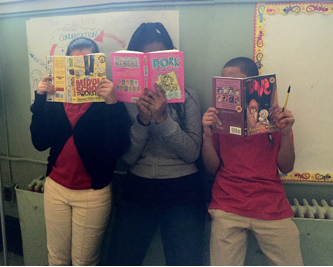“Reading gives us some place to go when we have to stay where we are.”– Mason Cooley![]()
Mason Cooley took the words right out of my mouth. As an avid reader, I have experienced the beauty of finding myself lost in another world within the pages of a book. Unfortunately, not all students may have had this type of opportunity. It shouldn’t come as a surprise that the first step to creating a well-rounded classroom library should not only intrigue and motivate students to want to open a book but also meet their diverse learning needs.
Here are my top 5 ways to build a classroom library:
- Create a classroom library without breaking the bank. Check all of your resources before heading to the closest department bookstore or even the school book fair. You can find gems while visiting local garage and yard sales, as well as thrift shops. Ask for donations from your family and friends. Look into your school’s policies in terms of grants or donors, and explore resources like Donors Choose to request materials for your classroom and First Book for discounted books.
2. Listen to and know your students. Think back to your favorite book, author, or series that you loved at your students’ age. Even though you ate them up, these types of books may or may not be as relevant to your group of students. If you want to have books in your library that students want to read, you need to ask them and get to know your students. Reading conferences can serve as a time to discuss books that students are currently reading or topics that they would be interested in learning more about. Readers notebooks can also provide insight into the reading patterns of your students. Have students record how often they read and the title and author of each book to open up your library to books you may have not considered.
3. Be thoughtful about your classroom community. The books in your classroom library need to not only reflect the topics and interests of your students but your students themselves. Can your students see themselves in these books? Do the characters and stories build understanding of diverse cultures and experiences? Reading books with diverse characters and content not only builds self-confidence through making personal cultural connections but also promotes empathy and understanding. A truly culturally responsive library does involve awareness and research. For more information, check out 8 Steps to Creating a Diverse Book Collection.
4. Consider the more formal aspects of a library. In addition to finding books that fit  student interest, it is important to consider the accessibility of your books. Having a variety of books that cover a range of genres from graphic novels to biographies to poetry allows students to not only read for personal interest but supplement grade-level content learning in the classroom. So organizing books by not only theme but also level is also important to support students when selecting independent books within an appropriately challenging range. This includes having books both below and above grade level. But this doesn’t mean you should discourage a child from picking up a book just because it is not necessarily at his or her level, as their interest and motivation in the book’s topic plays a significant factor in overall comprehension.
student interest, it is important to consider the accessibility of your books. Having a variety of books that cover a range of genres from graphic novels to biographies to poetry allows students to not only read for personal interest but supplement grade-level content learning in the classroom. So organizing books by not only theme but also level is also important to support students when selecting independent books within an appropriately challenging range. This includes having books both below and above grade level. But this doesn’t mean you should discourage a child from picking up a book just because it is not necessarily at his or her level, as their interest and motivation in the book’s topic plays a significant factor in overall comprehension.
5. Overcome the bumps with inspiration. “Reading is SO boring.” “There is nothing here that I want to read.” “I will never finish a book.” “I HATE reading.” Resistance and frustration are sometimes unfortunate parts of the process, but if met with a student-driven effort to identify each reluctant reader’s obstacles and ways to overcome them, negative attitudes toward reading can be turned around. Besides assessing your students’ reading levels and stocking your library with a wide range of interests, sometimes it is worth the time investment to go beyond the classroom for a little added spark. For example, inviting authors and illustrators to your classroom to share their writing or drawing processes can be a game changer for students. Many students have never met an author or illustrator before, and meeting the minds behind the books they’ve read is an inspiring experience for students.
Authentic reading experiences beyond your classroom, such as class trips to the local public library or bookstore, can help get your kids excited about reading. It’s important to provide students with experiences that show them that reading isn’t just an activity done in school. Personally, the best field trip I have attended so far was to Belmont Library in Bronx, NY. M class was able to have free reign of the library for nearly two hours and browse the selection to find their “just right” books. The highlight of the day was a student walking toward me with an armful of books asking, “How many books can I check out, Ms. Panko?” Giving students the opportunity to explore with your support gives them the freedom to internalize a love of reading.
 Lindsay is a recent graduate from Mount Saint Mary College and is currently pursuing her Master’s Degree in Literacy Education. She currently holds New York State certifications for childhood (1-6) and students with disabilities (1-6). Lindsay is a first year teacher in the Bronx working as a sixth grade special education teacher. She enjoys hiking throughout the Hudson Valley and baking during her free time.
Lindsay is a recent graduate from Mount Saint Mary College and is currently pursuing her Master’s Degree in Literacy Education. She currently holds New York State certifications for childhood (1-6) and students with disabilities (1-6). Lindsay is a first year teacher in the Bronx working as a sixth grade special education teacher. She enjoys hiking throughout the Hudson Valley and baking during her free time.


One thought on “Building Your Classroom Library: 5 Things to Consider”
Comments are closed.